Feasibility Study on the “New Traditional” Model and Energy-Saving Strategy for Chinese–Korean Vernacular Living Under the Construction of Border Villages
Abstract
1. Introduction
- (1)
- Limited analysis of life-cycle costs and payback periods for integrated systems in low-income rural settings;
- (2)
- Insufficient attention to esthetic and material compatibility with traditional architectural forms;
- (3)
- A lack of empirical data on system-level energy performance under real-world rural operating conditions.
2. Analysis of Chinese–Korean Dwellings in Border Villages
2.1. Traditional Dwellings in Border Villages
2.2. The Current Situation of Research on Border Rural Dwellings
- (1)
- Excessive summer indoor temperatures: during daytime hours in summer, indoor temperatures reach 30–35 °C, with perceived temperatures exceeding 40 °C, rendering the environment unsuitable for comfortable habitation
- (2)
- Inconvenient domestic hot water supply: only a small proportion of households are equipped with storage-type electric water heaters (approximately 3300 W power rating). These devices consume 120 kWh of electricity monthly, costing 63 RMB—accounting for over 80% of total monthly electricity expenditures. Consequently, residents rarely utilize this system.
2.3. Definition of Chinese–Korean Folk Houses Under the “New Tradition”
3. The Renovation Strategy of Korean Houses Under the “New Tradition”
3.1. Selection of Typical Chinese–Korean Folk Houses
3.2. Renovation Strategy of Chinese–Korean Folk Houses
- (1)
- GSHP Performance: Utilizing stable underground temperatures, GSHP delivers heating and cooling with COP/EER values exceeding 4.5, outperforming coal boilers (COP ~ 1.2) and electric resistance systems (COP ~ 1.0). This reduces energy consumption by 60–70% and eliminates coal-related emissions.
- (2)
- BIPV Synergies: Beyond generating clean electricity, BIPV modules provide passive shading to reduce summer heat gain by 20–30%, while its modular design preserves courtyard layouts and roof esthetics.
- (3)
- System Resilience: Avoiding land-intensive infrastructure, the system aligns with ecological protection goals and maintains 25+ year operational lifespans under local tariff and subsidy conditions.
4. Application of Energy-Saving Strategies and Simulation Assessments
4.1. Case Selection, Model Building, and Simulation Settings
- (1)
- Model Construction: On-site measurements conducted in the countryside were used to calibrate the building’s relevant parameters via iterative optimization. Subsequently, the initial model was developed, adjacent surfaces were defined, and new thermal zones were created for spaces without designated thermal classifications (as shown in Figure 7);
- (2)
- File Export: The IDF file was exported for further analysis;
- (3)
- Parameter Setup: The model was imported into EnergyPlus 9.5 and saved, with key simulation parameters configured [15]. Convergence tolerance settings and the TARP radiation algorithm selection were based on technical guidelines and modeling practices aligned with ASHRAE Standard 90.2 for U.S. low-rise residential buildings (as detailed in Table 1, Table 2, Table 3 and Table 4);
- (4)
- Results: The optimal inclination angle of photovoltaic panels in Kaishan Tunzidong Village [16], Longjing City, Yanbian Prefecture (see Figure 8) is determined based on performance parameters such as photovoltaic system module efficiency and overall system loss, evaluated according to the Chinese national standard Performance Monitoring Guidelines for Photovoltaic Power Generation Systems (GB/T 34129-2017 [17]). Geoclimatic data for Kaishan Tunzidong Village, Longjing City, Yanbian Prefecture is derived from the typical meteorological year (TMY) dataset released by the National Renewable Energy Laboratory (NREL) in 2022. Changes in electricity consumption, carbon dioxide emissions, and human thermal comfort (PMV) before and after renovation are detailed in Table 5.
4.2. A Comprehensive Assessment of the “New Traditional” Dwellings
4.2.1. Construction and Weight Calculation of an Evaluation Index System for Korean Dwelling Renovation Based on AHP
- (1)
- Summary of benchmark layer results
| Scale | Number | Scale | Number |
|---|---|---|---|
| 1 | 5 | 1 | |
| 3 | 1/3 | ||
| 5 | 1/5 | ||
| 7 | 1/7 | ||
| 9 | 1/9 | ||
| 2, 4, 6, 8 | 5 | 2/1, 1/4, 1/6, 1/8 |
| Scale | Number | Scale | Number |
|---|---|---|---|
| 1 | 5 | 1 | |
| 3 | 1/3 | ||
| 5 | 1/5 | ||
| 7 | 1/7 | ||
| 9 | 1/9 | ||
| 2, 4, 6, 8 | 5 | 2/1, 1/4, 1/6, 1/8 | 1 |
| Scale | Number | Scale | Number |
|---|---|---|---|
| 1 | 8 | 1 | |
| 3 | 1/3 | ||
| 5 | 1/5 | ||
| 7 | 1/7 | ||
| 9 | 1/9 | ||
| 2, 4, 6, 8 | 2 | 2/1, 1/4, 1/6, 1/8 |
- (2)
- Judgment matrix and consistency test
| Technical Performance (B1) | Economic Viability (B2) | Appearance Preservation and Spatial Comfort (B3) | |
|---|---|---|---|
| technical performance (B1) | 1 | 1.38 | 1.33 |
| economic viability (B2) | 0.725 | 1 | 1 |
| appearance preservation and spatial comfort (B3) | 0.752 | 1 | 1 |
4.2.2. Scoring Methods and Quantitative Models
- (1)
- To achieve unified quantification of multiple indicators, the linear normalization mapping method is adopted. The actual values of indicators such as energy saving rate, system energy consumption ratio, payback period, initial investment cost, spatial comfort, and others are converted into scores on a 0–10 point scale. For positive indicators (the higher, the better) and negative indicators (the lower, the better), the following formulas are used, respectively:
- (2)
- Data source and parameter setting.
- Photovoltaic power generation system: installed capacity of 5 kW, annual power generation of about 6000 kWh, the power generation is given priority for self-consumption, surplus electricity is connected to the Internet, to achieve net zero power consumption of buildings;
- Heating/cooling system: the ground source heat pump system is adopted, and the heating performance coefficient (COP) is about 4.0, which significantly improves energy utilization efficiency;
- Thermal comfort evaluation: the PMV (Predicted Mean Vote) model was used for quantitative analysis, and the PMV = 1.45 (thermal perception was hot, poor comfort) before the modification, and the PMV = 0.038 after the modification (close to thermal neutrality, and the comfort was significantly improved);
- 1.
- Initial investment: ground source heat pump system (80,000 yuan) photovoltaic system (40,000 yuan), a total of 120,000 yuan;
- 2.
- Subsidy scenario assumption: considering the incentive policy of local governments for the application of renewable energy, assuming that the initial investment is subsidized by 50%, the actual user side investment is 60,000 yuan Electricity price parameters: the residential electricity price is 0.528 yuan/kWh of the first tier of electricity in Jilin Province, and the on-grid electricity price of surplus electricity is calculated at 0.30 yuan/kWh;
- 3.
- Annual energy saving income: including self-consumption savings (1091 kWh × 0.528 yuan/kWh ≈ 576 yuan) and surplus electricity grid income (about 5000 kWh × 0.30 yuan/kWh = 1500 yuan), totaling about 2076 yuan;
- 4.
- Static payback period: Under the condition of actual investment of 60,000 yuan after subsidy, the payback period is: 60,000 ÷ 2076 ≈ 28.9.
- (3)
- The scoring results of energy saving rate, system energy consumption ratio, payback period, cost, comfort and other indicators before and after renovation.
4.2.3. Based on the AHP Method and Expert Scoring Method, the Comprehensive Evaluation Score of Korean Houses Before and After Renovation Was Obtained
5. Conclusions
Author Contributions
Funding
Institutional Review Board Statement
Informed Consent Statement
Data Availability Statement
Conflicts of Interest
Appendix A. Expert Questionnaire
| Evaluation Index System A: Target Level for Korean House Renovation | |||||
| technical performance (B1) | economic viability (B2) | appearance preservation and spatial comfort (B3) | |||
| energy saving rate (C1) | system energy consumption ratio (C2) | payback period (C3) | initial investment cost (C4) | traditional appearance preservation (C5) | spatial comfort (C6) |
| Scale | Definitions and Descriptions | Scale | Definitions and Descriptions |
| 1 | B1 is just as important as B2 | 1 | B2 is just as important as B1 |
| 3 | B1 is slightly more important than B2 | 1/3 | B2 is slightly more important than B1 |
| 5 | B1 is significantly more important than B2 | 1/5 | B2 is significantly more important than B1 |
| 7 | B1 is more important than B2 | 1/7 | B2 is more important than B1 |
| 9 | B1 is definitely more important than B2 | 1/9 | B2 is definitely more important than B1 |
| 2, 4, 6 | The middle value between the two scales above | 1/2, 1/4, 1/6 | The middle value between the two scales above |
| Scale | Definitions and Descriptions | Scale | Definitions and Descriptions |
| 1 | B1 is just as important as B3 | 1 | B3 is just as important as B1 |
| 3 | B1 is slightly more important than B3 | 1/3 | B3 is slightly more important than B1 |
| 5 | B1 is significantly more important than B3 | 1/5 | B3 is significantly more important than B1 |
| 7 | B1 is more important than B3 | 1/7 | B3 is more important than B1 |
| 9 | B1 is definitely more important than B3 | 1/9 | B3 is definitely more important than B1 |
| 2, 4, 6 | The middle value between the two scales above | 1/2, 1/4, 1/6 | The middle value between the two scales above |
| Scale | Definitions and Descriptions | Scale | Definitions and Descriptions |
| 1 | B2 is just as important as B3 | 1 | B3 is just as important as B2 |
| 3 | B2 is slightly more important than B3 | 1/3 | B3 is slightly more important than B2 |
| 5 | B2 is significantly more important than B3 | 1/5 | B3 is significantly more important than B2 |
| 7 | B2 is more important than B3 | 1/7 | B3 is more important than B2 |
| 9 | B2 is definitely more important than B3 | 1/9 | B3 is definitely more important than B2 |
| 2, 4, 6 | The middle value between the two scales above | 1/2, 1/4, 1/6 | The middle value between the two scales above |
| Scale | Definitions and Descriptions | Scale | Definitions and Descriptions |
| 1 | C1 is just as important as C2 | 1 | C2 is just as important as C1 |
| 3 | C1 is slightly more important than C2 | 1/3 | C2 is slightly more important than C1 |
| 5 | C1 is significantly more important than C2 | 1/5 | C2 is significantly more important than C1 |
| 7 | C1 is more important than C2 | 1/7 | C2 is more important than C1 |
| 9 | C1 is definitely more important than C2 | 1/9 | C2 is definitely more important than C1 |
| 2, 4, 6 | The middle value between the two scales above | 1/2, 1/4, 1/6 | The middle value between the two scales above |
| Scale | Definitions and Descriptions | Scale | Definitions and Descriptions |
| 1 | C3 is just as important as C4 | 1 | C4 is just as important as C3 |
| 3 | C3 is slightly more important than C4 | 1/3 | C4 is slightly more important than C3 |
| 5 | C3 is significantly more important than C4 | 1/5 | C4 is significantly more important than C3 |
| 7 | C3 is more important than C4 | 1/7 | C4 is more important than C3 |
| 9 | C3 is definitely more important than C4 | 1/9 | C4 is definitely more important than C3 |
| 2, 4, 6 | The middle value between the two scales above | 1/2, 1/4, 1/6 | The middle value between the two scales above |
| Scale | Definitions and Descriptions | Scale | Definitions and Descriptions |
| 1 | C5 is just as important as C6 | 1 | C6 is just as important as C5 |
| 3 | C5 is slightly more important than C6 | 1/3 | C6 is slightly more important than C5 |
| 5 | C5 is significantly more important than C6 | 1/5 | C6 is significantly more important than C5 |
| 7 | C5 is more important than C6 | 1/7 | C6 is more important than C5 |
| 9 | C5 is definitely more important than C6 | 1/9 | C6 is definitely more important than C5 |
| 2, 4, 6 | The middle value between the two scales above | 1/2, 1/4, 1/6 | The middle value between the two scales above |
References
- Shan, Y.U. The general office of the central committee of the communist party of china and the general office of the state council issued the ‘’Five-year action plan for the improvement and improvement of rural human settlements (2021–2025). Environ. Sci. Manag. 2021, 46, 1–6. [Google Scholar]
- Pan, L.; Zhang, R.; Wang, X. Review on the structure and application of solar photovoltaic air collector. J. Asian Archit. Build. Eng. 2022, 22, 1373–1386. [Google Scholar] [CrossRef]
- Shi, F.; Wang, S.; Huang, J.; Hong, X. Design strategies and energy performance of a net-zero energy house based on natural philosophy. J. Asian Archit. Build. Eng. 2019, 19, 1–15. [Google Scholar] [CrossRef]
- Yang, S.; Ma, H.; Li, N.; Xu, S.; Guo, F. Energy-saving design strategies for industrial heritage in northeast China under the concept of ultra-low energy consumption. Energies 2025, 18, 1289. [Google Scholar] [CrossRef]
- Cao, Y.; Zhang, Z.; Jia, G.; Zhai, J.; Hao, J.; Zhang, M.; Jin, L. Performance prediction and analysis of solar-assisted ground-source heat pump systems in typical rural areas, China. Energies 2025, 18, 2208. [Google Scholar] [CrossRef]
- Bogdan, A.; Chambre, D.; Copolovici, D.M.; Bungau, T.; Bungau, C.C.; Copolovici, L. Heritage building preservation in the process of sustainable urban development: The case of Brasov medieval city, Romania. Sustainability 2022, 14, 6959. [Google Scholar] [CrossRef]
- Sun, H.; Zhu, B.; Yin, J.; Zhong, M.; Wang, K. Photovoltaic technology in rural residential buildings in China: A comprehensive review on applications, development and its benefits. J. Asian Archit. Build. Eng. 2024, 24, 851–865. [Google Scholar] [CrossRef]
- Francisco-Hernandez, A.; Moya-Acosta, S.L.; Aragón-Aguilar, A.; Carreto-Hernandez, L.G. A review of sustainable development in the harnessing geothermal and solar energy for approaching the residual heat utilization in refrigeration and district cooling systems. Discov. Sustain. 2025, 6, 505. [Google Scholar] [CrossRef]
- Chaofeng, L.; Yan, W.; Long, Z. Research on the Design and Optimal Configuration of a Combined Photovoltaic-Thermal and Air Source Heat Pump Heating System. Renew. Energy 2023, 41, 1454–1461. [Google Scholar]
- Chen, Y. Application of solar photovoltaic building integration in building energy saving technology. Urban Design 2025, 7, 37–43. [Google Scholar] [CrossRef]
- He, W.; Zhu, L. Research on solar-air source heat pump water heater in hot summer and warm winter area. Refrig. Air Cond. 2025, 25, 48–53. [Google Scholar]
- Zhiyue, W.; Xin, S.; Fang, F.; Gangcheng, W.; Yunjie, M. Co-optimization of building energy systems with renewable generations combining active and passive energy-saving. Appl. Energy 2023, 351, 121514. [Google Scholar] [CrossRef]
- Mintorogo, D.S.; Budhiyanto, A.; Elsiana, F.; Suprianto, F.D.; Sutrisno, T. Harvesting renewable energies through innovative kinetic honeycomb architectural facades: The mathematical & cfd modeling for wind turbine design optimization. J. Asian Archit. Build. Eng. 2022, 21, 2593–2604. [Google Scholar]
- Wang, D.; Dong, Q.; Sun, C. Evaluating the adaptation potential and retrofitting effectiveness of existing residential buildings in severe cold regions of china under climate change. Build. Environ. 2025, 278, 112982. [Google Scholar] [CrossRef]
- Liang, X.; Zhang, H.; Sun, B. Parametric design of photovoltaic louver integrated shading devices for west facade windows of office buildings in central China. J. Asian Archit. Build. Eng. 2024, 24, 924–938. [Google Scholar] [CrossRef]
- Sheng, S.; Fang, L. Calculation of the optimal installation angle of photovoltaic panels taking into account meteorological conditions. Shaanxi Electr. Power 2014, 42, 42–45. [Google Scholar]
- GB/T 34129-2017; Microgrid Access to Distribution Network Testing Standards. China Standards Press: Beijing, China, 2017.
- Lu, J. Research on the Evaluation System of Green Village Residential Buildings in the Severe Cold Regions of Northeast China Based on the Analytic Hierarchy Process (AHP). Master’s Thesis, Harbin Institute of Technology, Harbin, China, 2016. [Google Scholar]
- Zhou, C.; Duann, M.; Li, X. Integrated appearance evaluation methods and models of photovoltaic buildings. Cent. China Archit. 2024, 42, 49–54. [Google Scholar]
- Liu, X.; Zhou, Q.; Huang, K.; Wu, Y.; Liang, C.; Cao, H.; Wei, J. Operating characteristics and evaluation of air source heat pumps in cold regions during heating season in China. Energy Built Environ. 2025, 6, 645–654. [Google Scholar] [CrossRef]
- Aelenei, L.; Rodrigues, C.; Brites, M.J.; Viana, S. Techno-economic analysis of a renewable energy based multigeneration system for zero energy buildings. Renew. Energy 2025, 247, 123002. [Google Scholar] [CrossRef]
- Politi, V. Methodology for economic assessment of energy-saving solutions in the reconstruction projects of residential buildings. MATEC Web Conf. 2018, 170, 01136. [Google Scholar] [CrossRef]
- Jin, R.; Zhen, T. Architectural aesthetics based on the perspective of traditional houses. Sichuan Build. Mater. 2020, 46, 58–59. [Google Scholar]
- Anonymous. JGJ 26—2018 “Energy Efficiency Design Standards for Residential Buildings in Extremely Cold and Cold Regions” and four other standards released. Heat. Vent. Air Cond. 2019, 49, 66. [Google Scholar]
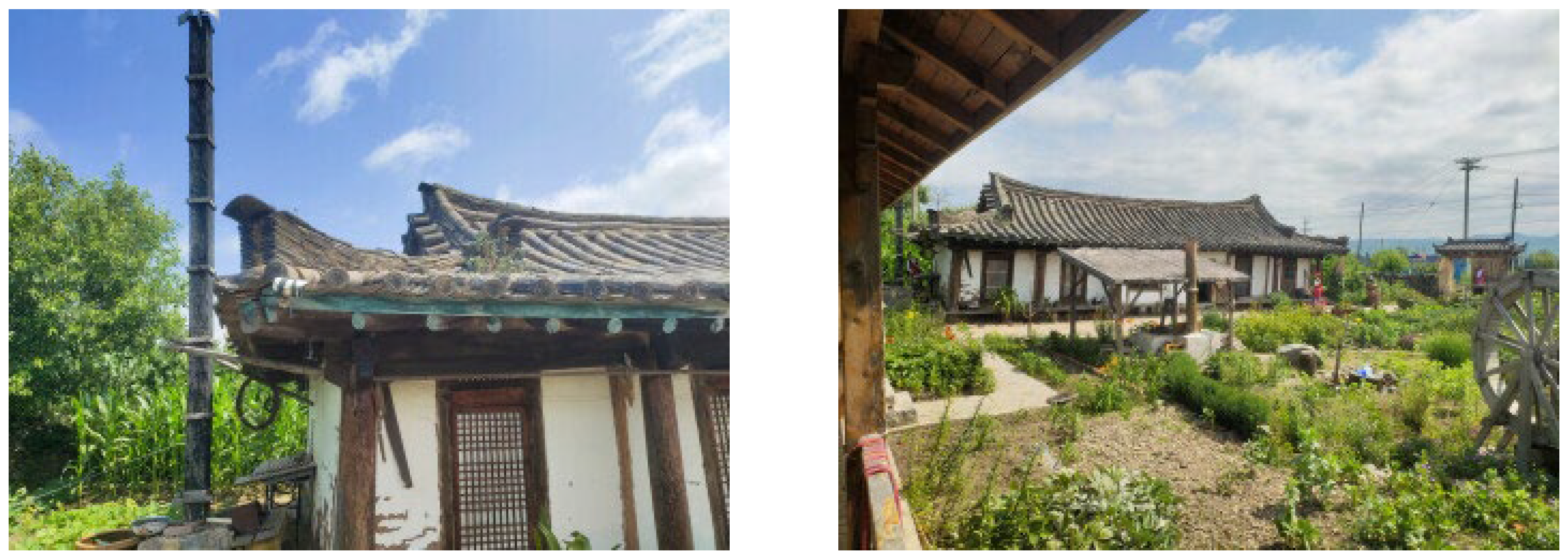

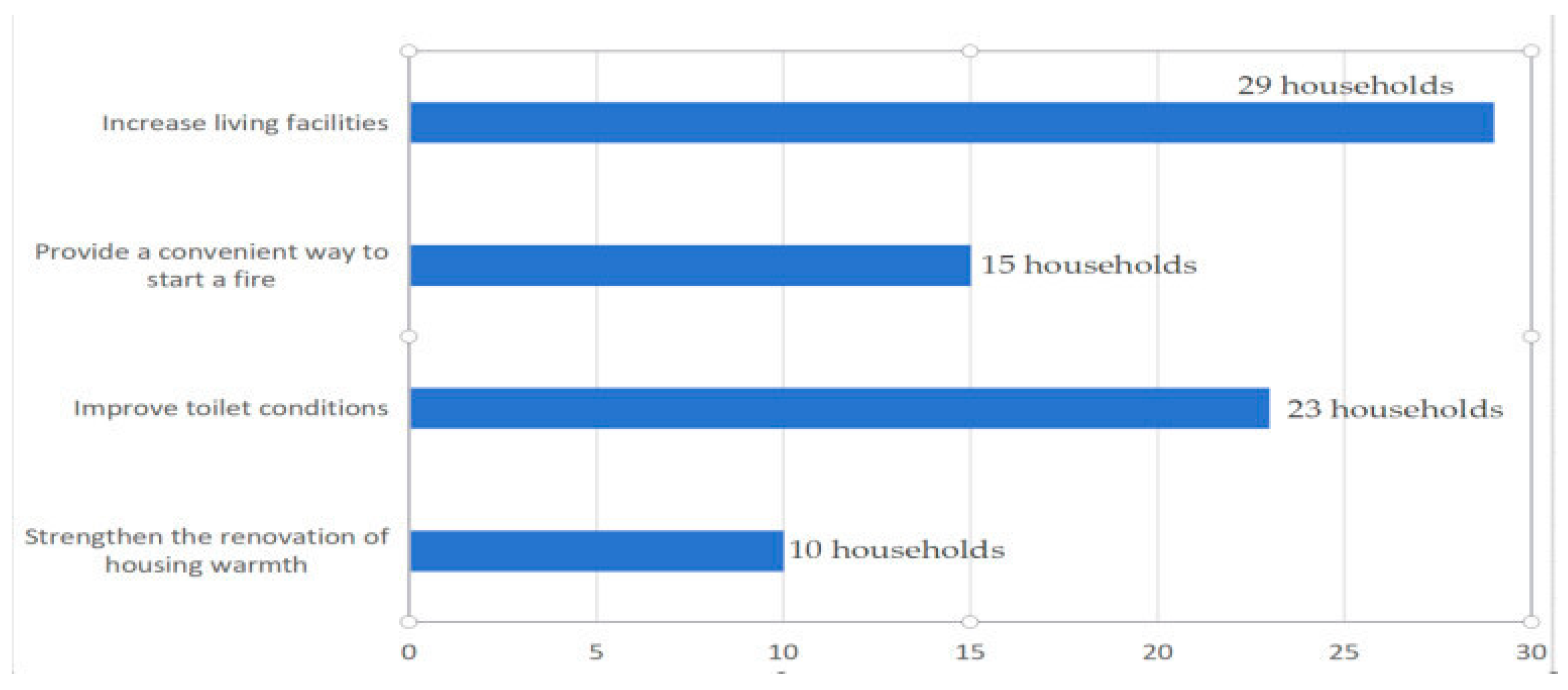
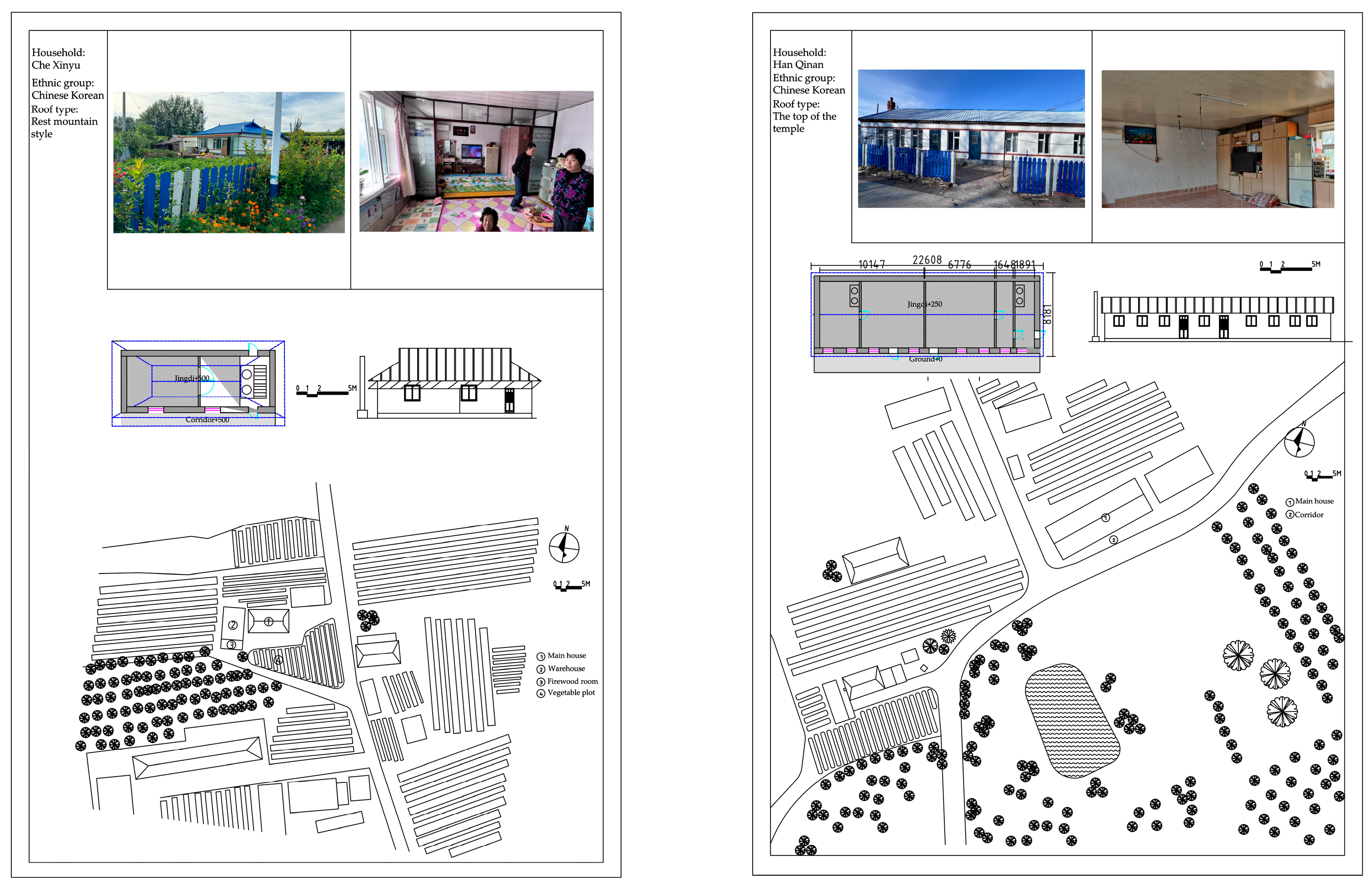
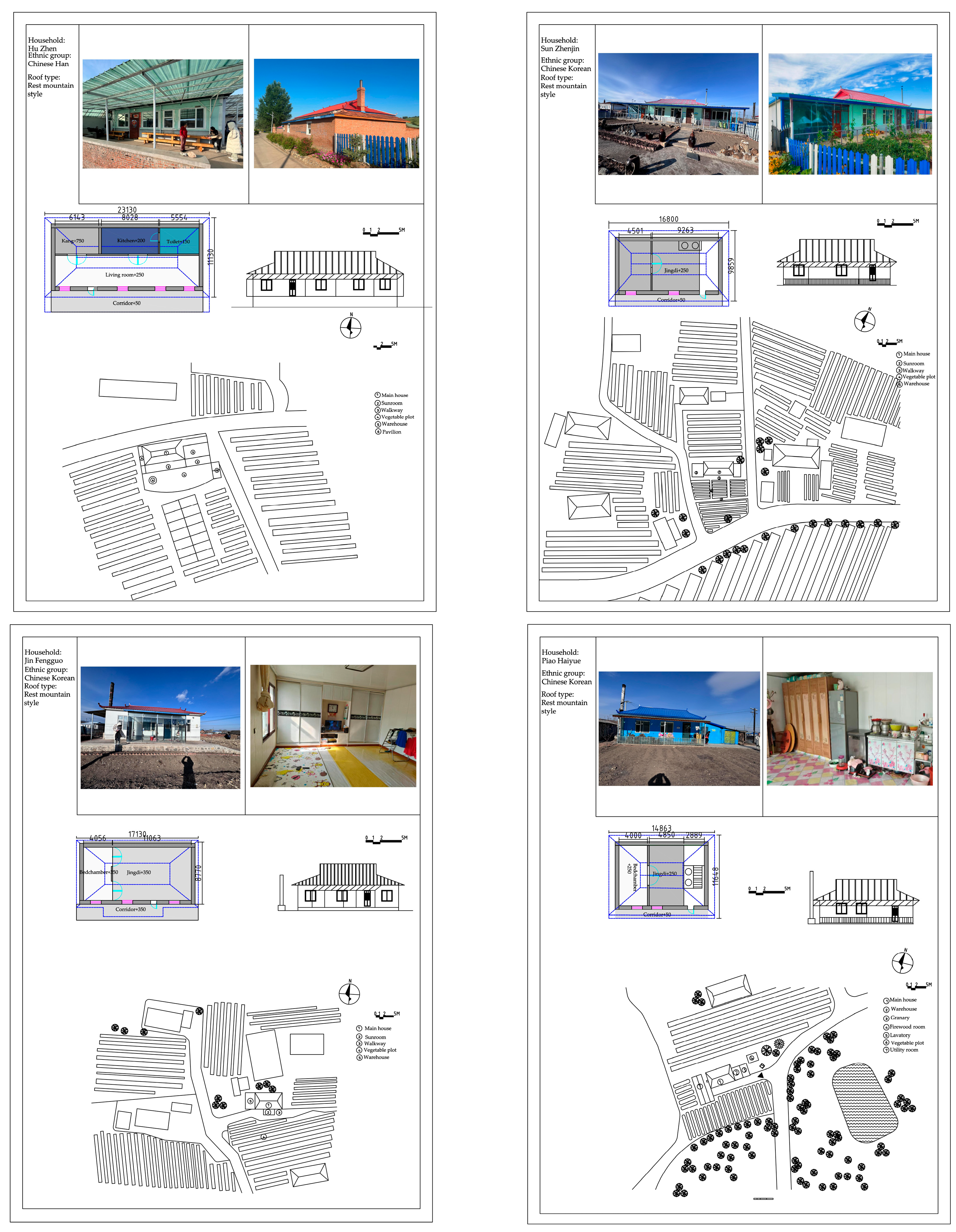

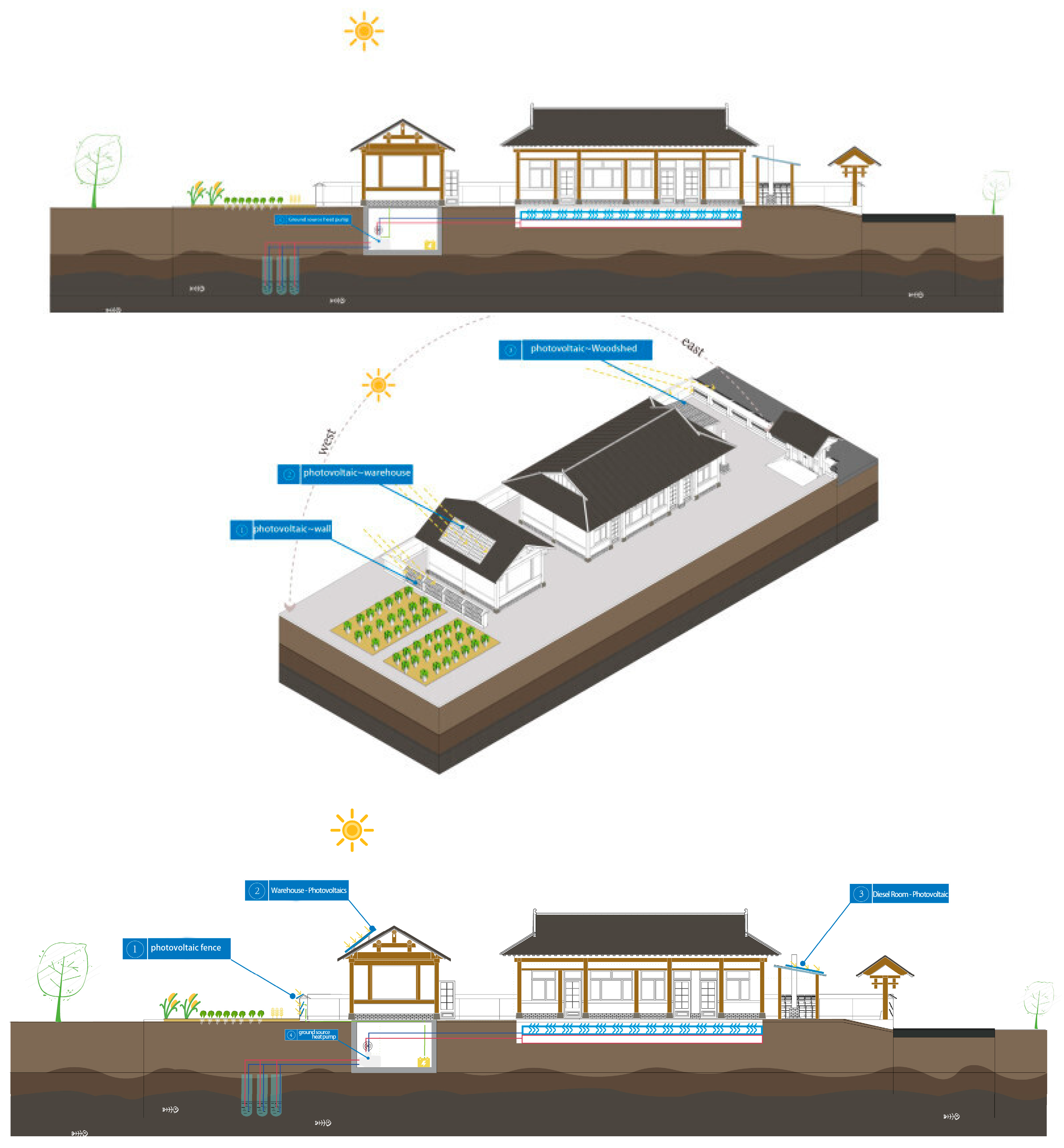
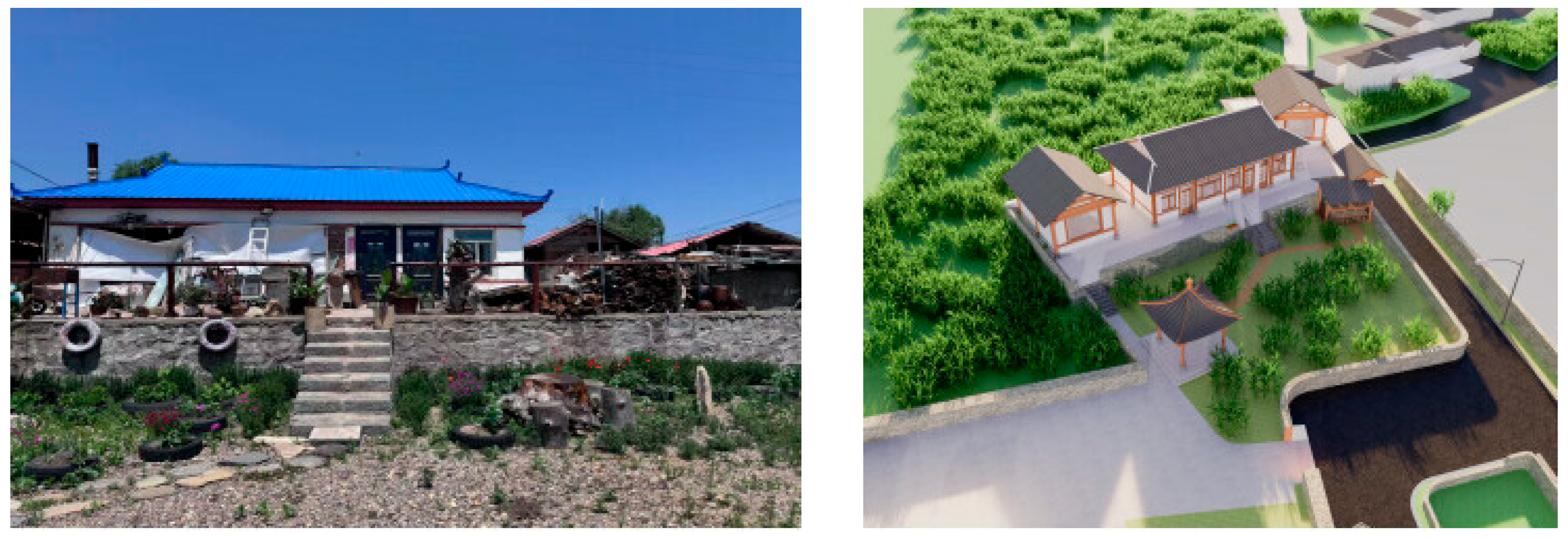
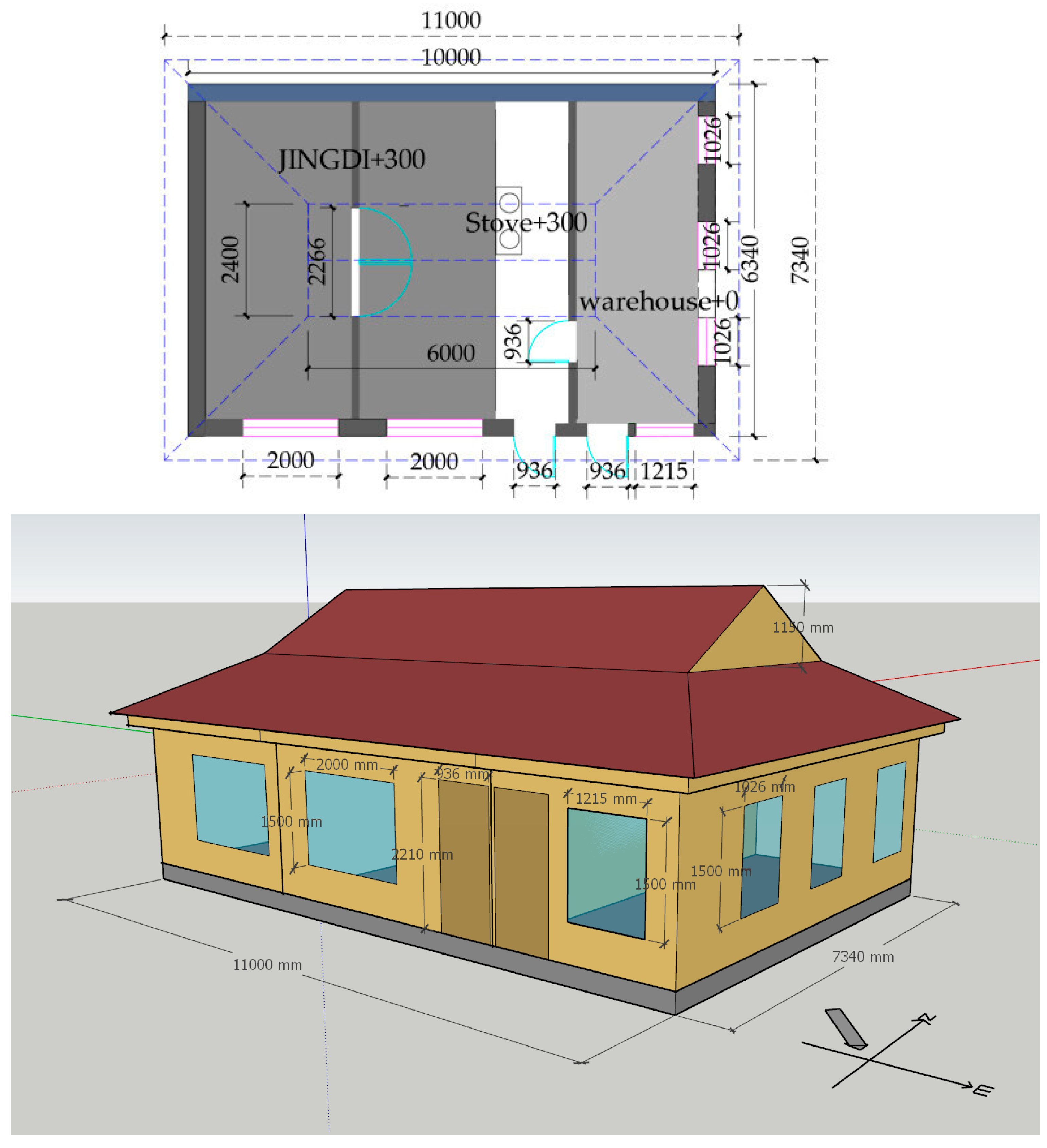
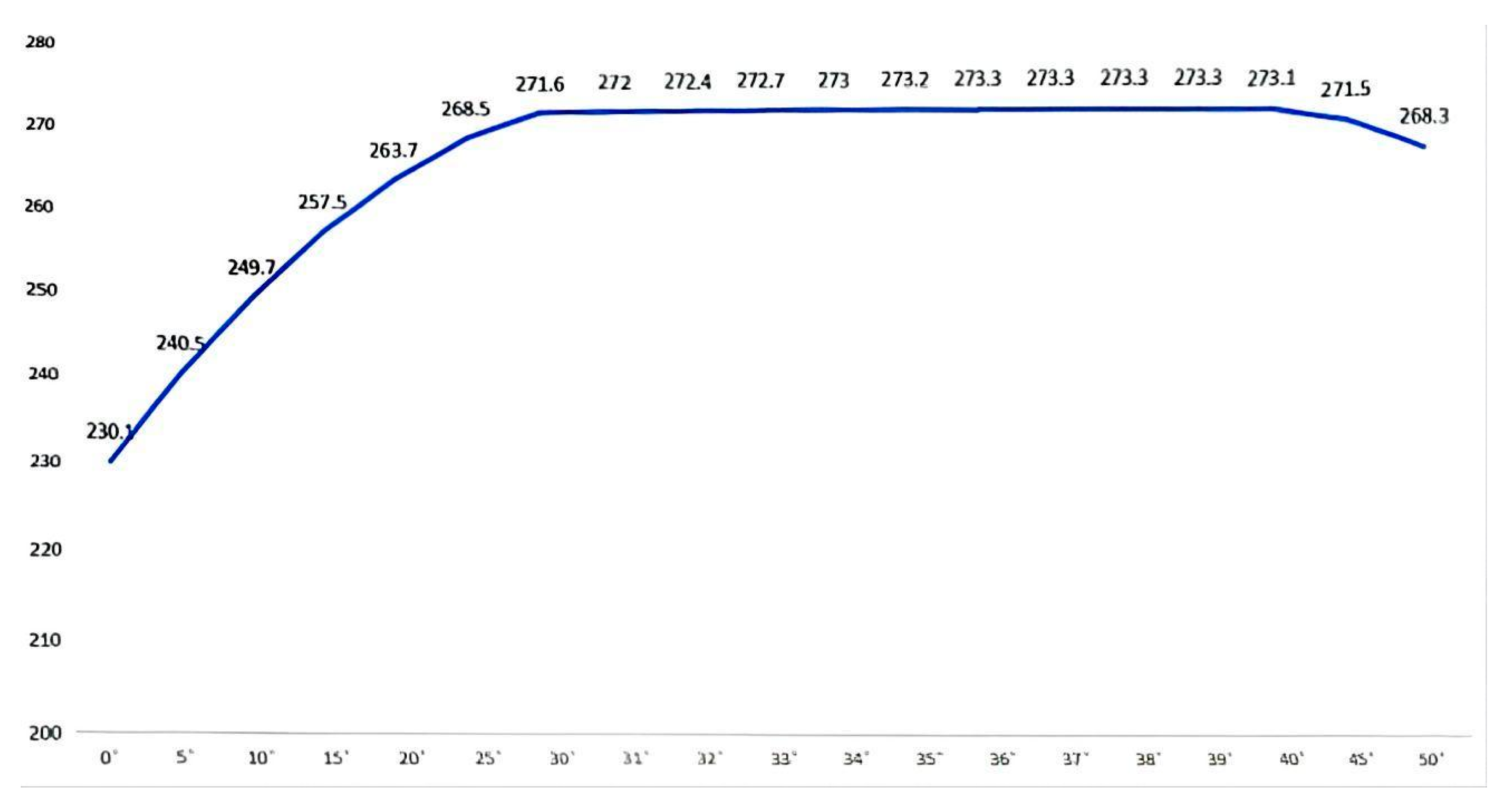
| Equipment Water Heater | Power (W) | Month of Use (Month) | Daily Usage Duration | Annual Electricity Consumption (kWh) |
|---|---|---|---|---|
| Ground source heat pump (heating) | 875 | 11–12 1–3 (month) | 10 h | 1312.5 |
| Ground source heat pump (refrigeration) | 1225 | 7–9 (month) | 10 h | 1102.5 |
| Air energy water heaters | 750 | 1–12 (month) | 30 min | 136.875 |
| Structure Name | Constructing Practices |
|---|---|
| Facades | 20 mm cement mortar 100 mm extruded polystyrene plastic 20 mm cement mortar 200 mm aerated bricks 200 mm cement mortar |
| Roof | 50 mm rebar mesh 100 mm cement mortar |
| Qall | 100 mm cement mortar 30 mm wooden flooring |
| Window 5 12A 5 Low-E | 5 12A 5 Low-E glass |
| Security doors | 5 mm iron sheet |
| Internal Surface Reflectance Ratio | Thermal Coefficient of Solar Energy | Visible Light Transmission Ratio | Heat Transfer Coefficient | |
|---|---|---|---|---|
| Cement mortar | 0.32 | 0 | 2.0 W/(m2·K) | |
| Extruded polystyrene plastic | 0.7 | 0 | 0.04 W/(m2·K) | |
| Aerated bricks | 0.6 | 0 | 0.16 W/(m2·K) | |
| Rebar mesh | 0.2 | 0 | 50 W/(m2·K) | |
| Wooden flooring | 0.2 | 0 | 0.20 W/(m2·K) | |
| Window 5 12A 5 Low-E | 0.2 | 0.3 | 0.6 | 1.9 W/(m2·K) |
| Stainless steel security door | 0.2 | 0 | 3.0 W/(m2·K) |
| Building’s File Settings | ||
|---|---|---|
| Field | Units | Obj1 |
| Name | Warehouse | |
| North Axis | deg | 0 |
| Terrain | Urban | |
| Loads Convergence Tolerance Value | W | 0.04 |
| Temperature Convergence Tolerance Value | deltaC | 0.4 |
| Solar Distribution | Full Exterior | |
| Maximum Number of Warmup Days | 15 | |
| Minimum Number of Warmup Days | 6 | |
| Version of the file settings | ||
| Field | Units | Obj1 |
| Version Identifier | 9.6 | |
| Surface Convection Algorithm: File settings for Inside | ||
| Field | Units | Obj1 |
| Algorithm | TARP | |
| Site: Location file settings | ||
| Field | Units | Obj1 |
| Name | CHN Jilin Yanji Longjing | |
| Latitude | 42.88 | |
| Longitude | 129.47 | |
| Time Zone | 8 | |
| Elevation | 176.8 | |
| Types of Renovations | Electricity Consumption (kWh) | CO2 Emissions (tCO2) | PMV (Predicted Mean Vote) |
|---|---|---|---|
| Basic type of house | −1091 kWh | −0.6 tCO2 | 1.45 |
| “new traditional” type of house | +2551.875 kWh | +1.403 tCO2 | 0.038 |
| Evaluation Index System A: Target Level for Korean House Renovation | |||||
|---|---|---|---|---|---|
| technical performance (B1) | economic viability (B2) | appearance preservation and spatial comfort (B3) | |||
| energy saving rate (C1) | system energy consumption ratio (C2) | payback period (C3) | initial investment cost (C4) | traditional appearance preservation (C5) | spatial comfort (C6) |
| Target Layer Proportion | Benchmark Layer Weights | Indicator Layer Proportion |
|---|---|---|
| Target Level for Korean House Renovation A = 1 | technical performance (B1) = 0.4 | energy saving rate (C1) = 0.6, system energy consumption ratio (C2) = 0.4 |
| economic viability (B2) = 0.3 | payback period (C3) = 0.5, initial investment cost (C4) = 0.5 | |
| appearance preservation and spatial comfort (B3) = 0.3 | traditional appearance preservation (C5) = 0.5, spatial comfort (C6) = 0.5 |
| Indicator Layer C | Ideal Value (10 Points) | Minimum Value (10 Points) | Data Source/Basis |
|---|---|---|---|
| energy saving rate (C1) | ≥80% | 0% | “Energy Saving Design Standard for Residential Buildings in Severe Cold and Cold Areas” JGJ 26-2018 [24] |
| system energy consumption ratio (C2) | ≤0.3 | 1.0 | The theoretical energy efficiency ratio of ground source heat pump system is COP ≥ 3.3 |
| payback period (C3) | ≤10 | ≥50 | Economic evaluation practice of building energy conservation projects |
| initial investment cost (C4) | ≤10 | ≥20 | Research on the cost of rural housing renovation in Yanbian area |
| spatial comfort (C6) | ≤0.5 | ≥1.5 | ISO 7730 thermal comfort standard |
| Indicator Layer C | Before the Reform, the Korean Ethnic Group Scored | After the Transformation, the Korean Ethnic Group Scored |
|---|---|---|
| energy saving rate (C1) | 0.0 | 10.0 |
| system energy consumption ratio (C2) | 5.7 | 10.0 |
| payback period (C3) | 0.0 | 3.5 |
| initial investment cost (C4) | 10.0 | 10.0 |
| spatial comfort (C6) | 0.3 | 9.8 |
| Grade | Number | Grade | Number |
|---|---|---|---|
| 1 | 6 | ||
| 2 | 7 | ||
| 3 | 8 | ||
| 4 | 9 | 5 | |
| 5 | 10 |
| Grade | Number | Grade | Number |
|---|---|---|---|
| 1 | 6 | 5 | |
| 2 | 7 | ||
| 3 | 8 | ||
| 4 | 9 | ||
| 5 | 10 |
| Grade | Number | Grade | Number |
|---|---|---|---|
| 1 | 6 | ||
| 2 | 7 | ||
| 3 | 8 | ||
| 4 | 9 | ||
| 5 | 10 | 5 |
| Grade | Number | Grade | Number |
|---|---|---|---|
| 1 | 6 | ||
| 2 | 7 | 5 | |
| 3 | 8 | ||
| 4 | 9 | ||
| 5 | 10 |
| Types of Dwellings | Expert Weight | Average Score From Experts | Resident Weight | Average Score of Residents | Composite Score (Total Score) |
|---|---|---|---|---|---|
| Before the reform, the Korean ethnic group scored | 0.6 | 4.5 | 0.4 | 5 | 4.7 |
| After the transformation, the Korean ethnic group scored | 0.6 | 3 | 0.4 | 3.5 | 3.2 |
| Indicator Layer (A) | Weight | Before the Reform, the Korean Ethnic Group Scored | After the Transformation, the Korean Ethnic Group Scored |
|---|---|---|---|
| energy saving rate (C1) | 0.6 | 0 | 6 |
| system energy consumption ratio (C2) | 0.4 | 2.28 | 4 |
| payback period (C3) | 0.5 | 0 | 1.75 |
| initial investment cost (C4) | 0.5 | 5 | 5 |
| traditional appearance preservation (C5) | 0.5 | 2.35 | 1.8 |
| spatial comfort (6) | 0.5 | 0.15 | 4.49 |
| Benchmark Layers B | Weight | Before the Reform, the Korean Ethnic Group Scored | After the Transformation, the Korean Ethnic Group Scored |
|---|---|---|---|
| technical performance (B1) | 0.4 | 0.912 | 4 |
| economic viability (B2) | 0.3 | 1.5 | 2.025 |
| appearance preservation and spatial comfort (B3) | 0.3 | 0.75 | 1.887 |
| 3.162 | 7.912 |
Disclaimer/Publisher’s Note: The statements, opinions and data contained in all publications are solely those of the individual author(s) and contributor(s) and not of MDPI and/or the editor(s). MDPI and/or the editor(s) disclaim responsibility for any injury to people or property resulting from any ideas, methods, instructions or products referred to in the content. |
© 2025 by the authors. Licensee MDPI, Basel, Switzerland. This article is an open access article distributed under the terms and conditions of the Creative Commons Attribution (CC BY) license (https://creativecommons.org/licenses/by/4.0/).
Share and Cite
Chu, W.; Xiang, J.; Jin, C. Feasibility Study on the “New Traditional” Model and Energy-Saving Strategy for Chinese–Korean Vernacular Living Under the Construction of Border Villages. Buildings 2025, 15, 3838. https://doi.org/10.3390/buildings15213838
Chu W, Xiang J, Jin C. Feasibility Study on the “New Traditional” Model and Energy-Saving Strategy for Chinese–Korean Vernacular Living Under the Construction of Border Villages. Buildings. 2025; 15(21):3838. https://doi.org/10.3390/buildings15213838
Chicago/Turabian StyleChu, Weiming, Junjie Xiang, and Changjie Jin. 2025. "Feasibility Study on the “New Traditional” Model and Energy-Saving Strategy for Chinese–Korean Vernacular Living Under the Construction of Border Villages" Buildings 15, no. 21: 3838. https://doi.org/10.3390/buildings15213838
APA StyleChu, W., Xiang, J., & Jin, C. (2025). Feasibility Study on the “New Traditional” Model and Energy-Saving Strategy for Chinese–Korean Vernacular Living Under the Construction of Border Villages. Buildings, 15(21), 3838. https://doi.org/10.3390/buildings15213838




